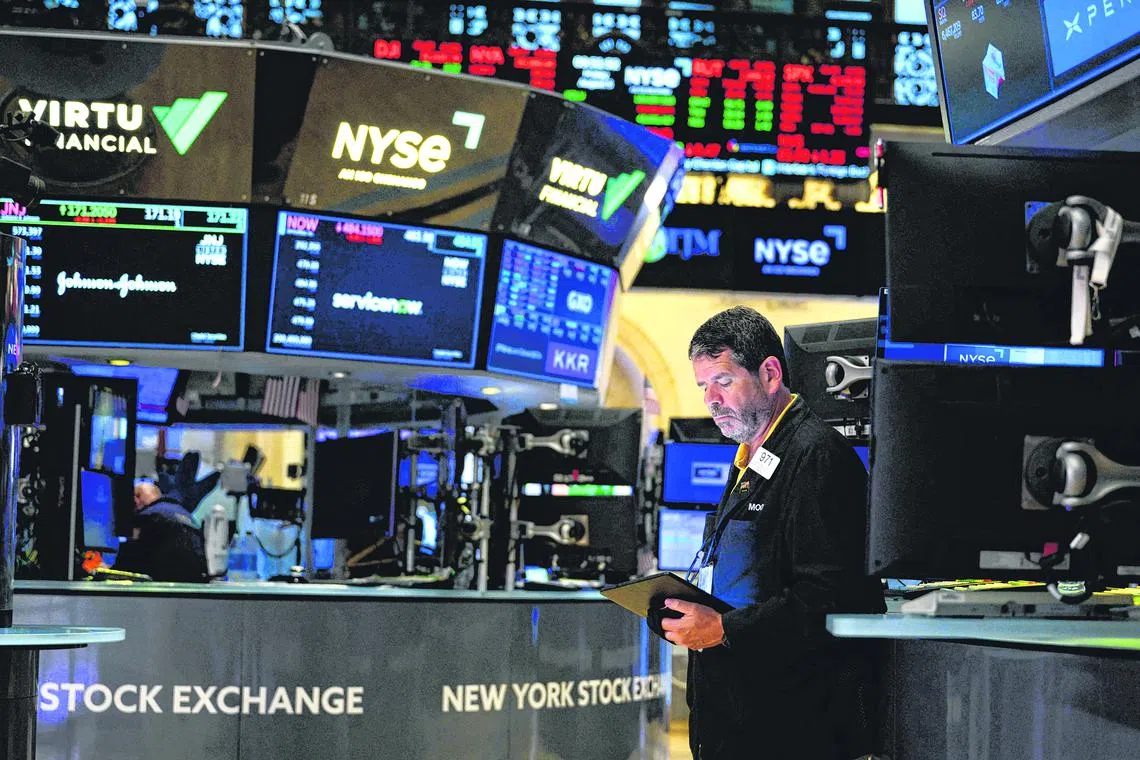Fears of recession roil markets
Sign up now: Get ST's newsletters delivered to your inbox

Wall Street’s main indexes notched a second consecutive week of losses last Friday.
PHOTO: AFP
Follow topic:
The prospect of a looming recession in 2023 amid higher-for-longer interest rates and signs of falling consumer spending weighed heavily on the markets last week, sending Wall Street stocks to their lowest levels since late October.
This came after the US Federal Reserve raised its key lending rate by an expected 50 basis points
The fear now is that the Fed’s stubbornness in sticking to a 2 per cent inflation target – which increasing numbers of economists say is unrealistic and unattainable – might send the United States and global economy into a deep recession in 2023.
Wall Street’s main indexes notched a second consecutive week of losses last Friday, with the Dow losing 1.7 per cent for the week to 32,920.46 points.
Meanwhile the S&P 500 fell 2.08 per cent last Friday to close at 3,852.36 points, totalling its December losses at 5.58 per cent. The tech-heavy Nasdaq fell 2.7 per cent to 10,705.41 points.
The selling began last Wednesday in the wake of the Fed’s latest boost in its overnight borrowing rate. The central bank also said it will continue raising rates in 2023 and projected its funds rate to peak at a higher than expected 5.1 per cent. With last Wednesday’s half-percentage point rise, the targeted range for rates is now 4.25 per cent to 4.5 per cent, the highest in 15 years.
Trading was particularly volatile last Friday, with a large amount in options expiring. According to Goldman Sachs, US$2.6 trillion (S$3.5 trillion) worth of index options was expiring, the highest amount “relative to the size of the equity market in nearly two years”.
Meanwhile, the Fed’s latest updated economic projections seem to incorporate an assumption that inflation would prove resurgent in December. Its quarterly projections show that Fed officials now expect so-called core inflation – which excludes food and energy – to end in 2022 at around 4.8 per cent, up from the 4.5 per cent they forecast in September.
In Singapore, a decelerating global growth outlook has gradually factored into the local market, with the Straits Times Index stalling at around the 3,200 level over the past three weeks. It closed at 3,240.81 points last Friday, almost flat from a week earlier. This comes amid data showing a sharp fall in non-oil domestic exports in November, signalling a potential economic slowdown.
So what next?
As the Fed readies a slower path of rate increases ahead, investors remain wary of the risk that the US central bank could tighten too much and argue for a pause sooner rather than later, as the rate increases delivered so far need time to take effect on the economy.
Allianz chief economic adviser Mohamed El-Erian reckons the Fed may have to abandon its 2 per cent inflation target in 2023 as it falls behind in its fight against rising prices because of past policy mistakes.
This view is echoed by billionare investor Bill Ackman – founder of hedge fund Pershing Square Capital Management – who sees the Fed sending the US economy tanking if it tries to wrestle inflation back down to its target rate of 2 per cent.
These and increasing numbers of other experts reckon the Fed will have to settle for a 3 per cent inflation goal instead, given that structural forces are exerting permanent upward pressure on prices. These forces include deglobalisation, the expensive transition from fossil fuels to renewable energy, rising wages and tight supply chains.
The big question is whether the Fed will budge.
“A recession is still not fully priced into the markets as analysts have not downgraded their earnings forecasts for 2023 materially,” warned Mr Vasu Menon, executive director for investment strategy at OCBC Bank. “However, as a recession becomes more evident in 2023, the earnings shoe may be the next to drop, weighing on the markets and possibly causing a significant pullback in the first half of next year.”
Mr Kelvin Tay, chief investment officer for Asia-Pacific at UBS, was even more blunt.
“Let me summarise the circumstances for you: We have a very resilient US labour market as reflected by the jobless claims data, leading economic indicators trending down and a resolute Fed and ECB, with no easing in sight,” he said, referring to the European Central Bank. “The fundamental conditions are not in place for a sustainable rally, and markets got ahead of themselves in pricing in a brighter outlook via lower terminal rate and earlier easing, both of which are highly unrealistic.”
He pointed out that equity returns have been the highest in November since 1990 and the average performance of equities “tends to weaken into the following year”, with January equity returns likely to be weaker than average.
So much for hopes of a year-end rally.
That said, the outlook could improve if inflation eases sharply and the Fed signals a greater willingness to turn dovish as a recession stares it in the face. This could augur well for equities and help the asset class to stage a more sustainable rebound in the latter half of 2023 as idle liquidity on the sidelines goes to work.
But for now, markets will continue to dance to the mixed tune of good and bad news and gyrate between hope and fear as investors try to wrap their minds around where inflation, interest rates and the economy are headed in 2023. For Asian markets, the prospect of a China reopening brings some hope of relief.
Staying diversified and applying dollar-cost averaging could reduce investment risk, given the current uncertain environment.


